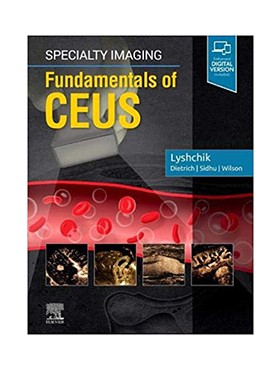
Cost-efficient, safe, and clinically effective, contrast-enhanced ultrasound is a nascent diagnostic imaging technique
for use in both adults and children.
Specialty Imaging: Fundamentals in CEUS provides first of its kind, authoritative coverage to help you make the most of
this promising imaging tool in your practice.
This one-stop resource is tailored to your decision support needs, offering guidance from global experts on everything
from physics and safety to each of the commonly used clinical applications of CEUS (Contrast-Enhanced Ultrasound).
Key Features
glands, gynecology, prostate, scrotum, breast, thyroid, parathyroid, and lymph nodes
evaluation, CEUS of thorax, intracavitary CEUS, endoscopic CEUS, abdominal trauma, and pediatric applications
recommendations and lexicon of imaging findings
accurate diagnosis than when using regular ultrasound, and providing alternative imaging methods for younger
patients where ionizing radiation poses greater risks
and references from the book on a variety of devices. 
Introduction
History of CEUS
Physical Principles of Microbubble-Based Contrast Agents Imaging
Safety and Biological Effects of Microbubble-Based Contrast Agents
Quantification
Cost Efficiency of CEUS
Ultrasound Contrast Agents
Ultrasound Contrast Agents: SonoVue/Lumason
Ultrasound Contrast Agents: Definity
Ultrasound Contrast Agents: Optison
Ultrasound Contrast Agents: Sonazoid
CEUS Technique
CEUS Technique: Machine Settings/Injection Setup
CEUS Technique: Protocols
CEUS Technique: Artifacts
CEUS Technique: Tips for Beginners
CEUS Technique: Pitfalls
CEUS Lexicon
Liver
Liver: CEUS Protocol
Liver: Benign Focal Lesions
Liver: Malignant Focal Lesions in Normal Liver
Liver: Focal Lesions in High-Risk Patients
Liver: CEUS LI-RADS
Liver: Tumor Imaging With Sonazoid
Liver: Multimodality Assessment of Focal Lesions (US, CEUS, CT, MR)
Liver: Transplant Evaluation
Liver: Diffuse Liver Disease/Portal Hypertension
Liver: Biliary Tract
Liver: Gallbladder
Liver: Pseudolesions
Liver: Infection
Kidney
Kidney: Benign Lesions
Kidney: Malignant Lesions
Kidney: Lesion Classification Approach
Kidney: Renal Infection
Kidney: Renal Transplant Evaluation
Bowel
Bowel: IBD
Bowel: Inflammatory Masses
Bowel: Tumors
Pancreas
Pancreas: Cystic Lesions
Pancreas: Solid Lesions
Pancreas: Pancreatitis
Spleen
Spleen: Benign Lesions
Spleen: Malignant Lesions
Spleen: Diffuse Disease
Adrenal Glands
Adrenal Glands: Benign Lesions
Adrenal Glands: Malignant Lesions
Adrenal Glands: Diffuse Disease
Gynecology
Gynecology: Uterine and Cervical Tumors
Gynecology: Benign Adnexal Masses
Gynecology: Malignant Adnexal Masses
Gynecology: Ovarion Torsion
Gynecology: Entopic Pregnancy
Gynecology: Pelvic Inflammatory Disease
Prostate
Prostate: Benign Lesions
Prostate: Malignant Lesions
Prostate: Diffuse Disease
Scrotum
Scrotum: Benign Lesions
Scrotum: Malignant Lesions
Scrotum: Diffuse Disease
Scrotum: Testicular Torsion
Breast
Breast: Benign Lesions
Breast: Malignant Lesions
Breast: Diffuse Disease
Thyroid
Thyroid: Benign Nodules
Thyroid: Thyroid Cancer
Thyroid: Acute and Chronic Thyroiditis
Parathyroid
Lymph Nodes
Vascular CEUS
CEUS-Guided Interventions
Preprocedure Evaluation and Procedure Guidance
CEUS in Treatment Response Evaluation
CEUS in Treatment Response Evaluation: Evaluation of Chemotherapy Response
CEUS in Treatment Response Evaluation: Cryoablation
CEUS in Treatment Response Evaluation: RFA and Microwaive
CEUS in Treatment Response Evaluation: TACE and Y-90
CEUS of Thorax
Intracavitary CEUS
Endoscopic CEUS
Abdominal Trauma
Pediatric Applications
Pediatric Applications: Focal Liver Lesions
Pediatric Applications: Focal Renal Lesions
Pediatric Applications: Bowel Imaging
Pediatric Applications: Voiding Urosongraphy (ceVUS)
Pediatric Applications: Small Parts


